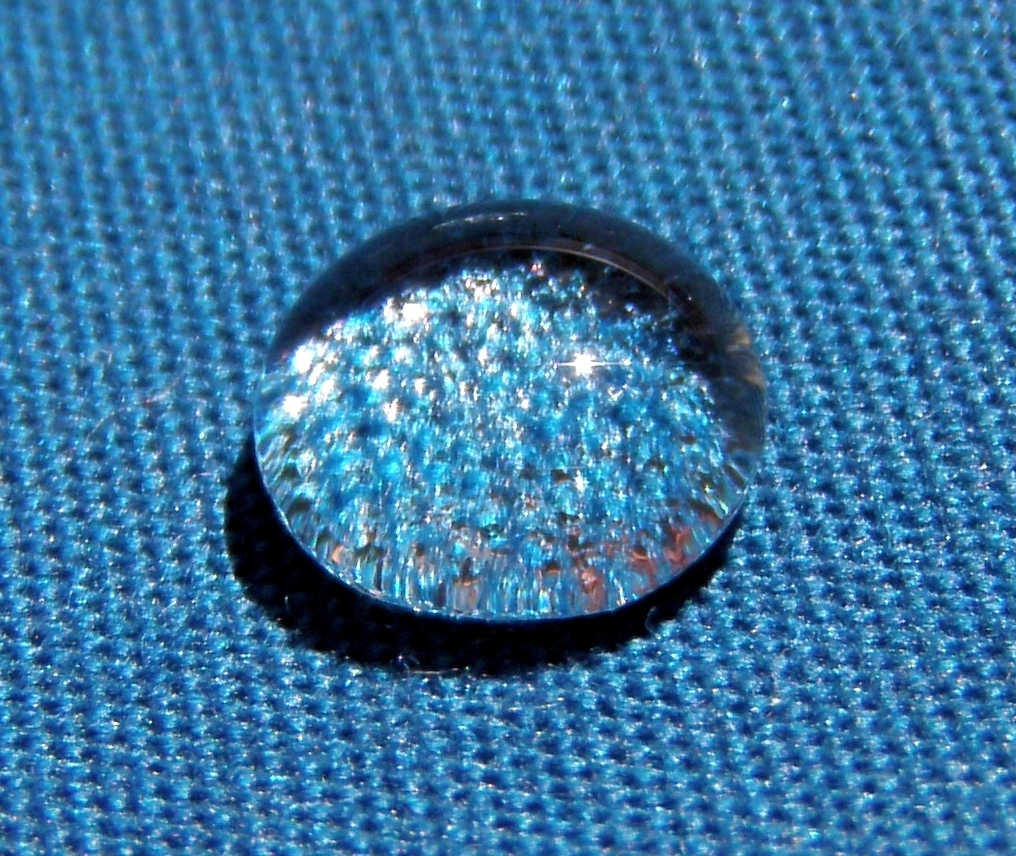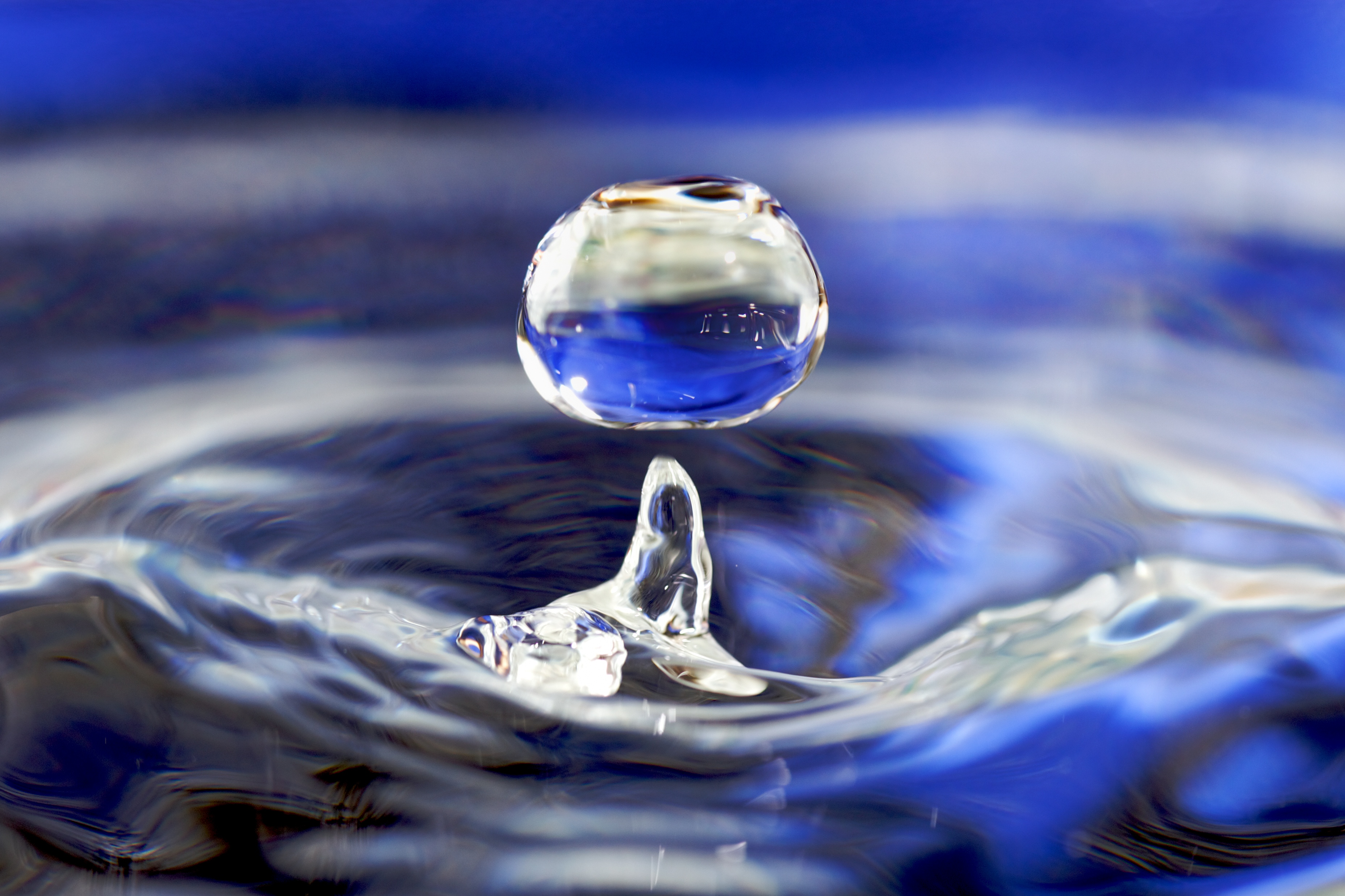|
Electrowetting
Electrowetting is the modification of the wetting properties of a surface (which is typically hydrophobic) with an applied electric field. History The electrowetting of mercury and other liquids on variably charged surfaces was probably first explained by Gabriel Lippmann in 1875 and was certainly observed much earlier. A. N. Frumkin used surface charge to change the shape of water drops in 1936. The term electrowetting was first introduced in 1981 by G. Beni and S. Hackwood to describe an effect proposed for designing a new type of display device for which they received a patent. The use of a "fluid transistor" in microfluidic circuits for manipulating chemical and biological fluids was first investigated by J. Brown in 1980 and later funded in 1984–1988 under NSF Grants 8760730 & 8822197, employing insulating dielectric and hydrophobic layer(s) (EWOD), immiscible fluids, DC or RF power; and mass arrays of miniature interleaved (saw tooth) electrodes with large or matching In ... [...More Info...] [...Related Items...] OR: [Wikipedia] [Google] [Baidu] |
Schottky Diode
The Schottky diode (named after the German physicist Walter H. Schottky), also known as Schottky barrier diode or hot-carrier diode, is a semiconductor diode formed by the junction of a semiconductor with a metal. It has a low forward voltage drop and a very fast switching action. The cat's-whisker detectors used in the early days of wireless and metal rectifiers used in early power applications can be considered primitive Schottky diodes. When sufficient forward voltage is applied, a current flows in the forward direction. A silicon p–n diode has a typical forward voltage of 600–700 mV, while the Schottky's forward voltage is 150–450 mV. This lower forward voltage requirement allows higher switching speeds and better system efficiency. History Walter H. Schottky (1886–1976) in 1914, discovered an irregularity in the emission of thermions in a vacuum tube, now known as the Schottky effect. Construction A metal–semiconductor junction is formed between a m ... [...More Info...] [...Related Items...] OR: [Wikipedia] [Google] [Baidu] |
Schottky Barrier
A Schottky barrier, named after Walter H. Schottky, is a potential energy barrier for electrons formed at a metal–semiconductor junction. Schottky barriers have rectifying characteristics, suitable for use as a diode. One of the primary characteristics of a Schottky barrier is the Schottky barrier height, denoted by ΦB (see figure). The value of ΦB depends on the combination of metal and semiconductor. Not all metal–semiconductor junctions form a rectifying Schottky barrier; a metal–semiconductor junction that conducts current in both directions without rectification, perhaps due to its Schottky barrier being too low, is called an ohmic contact. Physics of formation When a metal is put in direct contact with a semiconductor, a so called Schottky barrier can be formed, leading to a rectifying behavior of the electrical contact. This happens both when the semiconductor is n-type and its work function is smaller than the work function of the metal, and when the ... [...More Info...] [...Related Items...] OR: [Wikipedia] [Google] [Baidu] |
Photoelectrowetting
Photoelectrowetting is a modification of the wetting properties of a surface (typically a hydrophobic surface) using incident light. Working principle Whereas ordinary electrowetting is observed in surfaces consisting of a liquid/ insulator/conductor stack, photoelectrowetting can be observed by replacing the conductor with a semiconductor to form a liquid/insulator/semiconductor stack. This has electrical and optical properties similar to the metal/insulator/semiconductor stack used in metal-oxide-semiconductor field effect transistors (MOSFETs) and charge-coupled devices (CCDs). Replacing the conductor with a semiconductor results in asymmetrical electrowetting behavior (in terms of voltage polarity), depending on the semiconductor doping type and density. Incident light above the semiconductor's band gap creates photo-induced carriers via electron-hole pair generation in the depletion region of the underlying semiconductor. This leads to a modification of the capacitance of ... [...More Info...] [...Related Items...] OR: [Wikipedia] [Google] [Baidu] |
E-paper
Electronic paper, also sometimes electronic ink, e-ink or electrophoretic display, are display devices that mimic the appearance of ordinary ink on paper. Unlike conventional flat panel displays that emit light, an electronic paper display reflects ambient light like paper. This may make them more comfortable to read, and provide a wider viewing angle than most light-emitting displays. The contrast ratio in electronic displays available as of 2008 approaches newspaper, and newly (2008) developed displays are slightly better. An ideal e-paper display can be read in direct sunlight without the image appearing to fade. Many electronic paper technologies hold static text and images indefinitely without electricity. Flexible electronic paper uses plastic substrates and plastic electronics for the display backplane. Applications of electronic visual displays include electronic shelf labels and digital signage, bus station time tables, electronic billboards, smartphone displays, ... [...More Info...] [...Related Items...] OR: [Wikipedia] [Google] [Baidu] |
Optoelectrowetting
Optoelectrowetting (OEW) is a method of liquid droplet manipulation used in microfluidics applications. This technique builds on the principle of electrowetting, which has proven useful in liquid actuation due to fast switching response times and low power consumption. Where traditional electrowetting runs into challenges, however, such as in the simultaneous manipulation of multiple droplets, OEW presents a lucrative alternative that is both simpler and cheaper to produce. OEW surfaces are easy to fabricate, since they require no lithography, and have real-time, reconfigurable, large-scale manipulation control, due to its reaction to light intensity. Theory The traditional electrowetting mechanism has been receiving increasing interest due to its ability to control tension forces on a liquid droplet. As surface tension acts as the dominant liquid actuation force in nano-scale applications, electrowetting has been used to modify this tension at the solid-liquid interface through ... [...More Info...] [...Related Items...] OR: [Wikipedia] [Google] [Baidu] |
Wetting
Wetting is the ability of a liquid to maintain contact with a solid surface, resulting from intermolecular interactions when the two are brought together. This happens in presence of a gaseous phase or another liquid phase not miscible with the first one. The degree of wetting (wettability) is determined by a force balance between adhesive and cohesive forces. Wetting is important in the bonding or adherence of two materials. Wetting and the surface forces that control wetting are also responsible for other related effects, including capillary effects. There are two types of wetting: non-reactive wetting and reactive wetting. Wetting deals with three phases of matter: gas, liquid, and solid. It is now a center of attention in nanotechnology and nanoscience studies due to the advent of many nanomaterials in the past two decades (e.g. graphene, Carbon nano tube, carbon nanotube, boron nitride nanomesh). Explanation Adhesive forces between a liquid and solid cause a liq ... [...More Info...] [...Related Items...] OR: [Wikipedia] [Google] [Baidu] |
Gabriel Lippmann
Jonas Ferdinand Gabriel Lippmann (16 August 1845 – 13 July 1921) was a Franco-Luxembourgish physicist and inventor, and Nobel laureate in physics for his method of reproducing colours photographically based on the phenomenon of interference. His parents were French Jews. Early life and education Gabriel Lippmann was born in Bonnevoie, Luxembourg (Luxembourgish: Bouneweg), on 16 August 1845. At the time, Bonnevoie was part of the commune of Hollerich (Luxembourgish: Hollerech) which is often given as his place of birth. (Both places, Bonnevoie and Hollerich, are now districts of Luxembourg City.) His father, Isaïe, a French Jew born in Ennery near Metz, managed the family glove-making business at the former convent in Bonnevoie. In 1848, the family moved to Paris where Lippmann was initially tutored by his mother, Miriam Rose (Lévy), before attending the Lycée Napoléon (now Lycée Henri-IV). He was said to have been a rather inattentive but thoughtful pupil with a specia ... [...More Info...] [...Related Items...] OR: [Wikipedia] [Google] [Baidu] |
Indium Tin Oxide
Indium tin oxide (ITO) is a ternary composition of indium, tin and oxygen in varying proportions. Depending on the oxygen content, it can be described as either a ceramic or an alloy. Indium tin oxide is typically encountered as an oxygen-saturated composition with a formulation of 74% In, 18% Sn, and 8% O by weight. Oxygen-saturated compositions are so typical that unsaturated compositions are termed ''oxygen-deficient ITO''. It is transparent and colorless in thin layers, while in bulk form it is yellowish to gray. In the infrared region of the spectrum it acts as a metal-like mirror. Indium tin oxide is one of the most widely used transparent conducting oxides because of its electrical conductivity and optical transparency, the ease with which it can be deposited as a thin film, and its chemical resistance to moisture. As with all transparent conducting films, a compromise must be made between conductivity and transparency, since increasing the thickness and increasing the co ... [...More Info...] [...Related Items...] OR: [Wikipedia] [Google] [Baidu] |
Liquid
A liquid is a nearly incompressible fluid that conforms to the shape of its container but retains a (nearly) constant volume independent of pressure. As such, it is one of the four fundamental states of matter (the others being solid, gas, and plasma), and is the only state with a definite volume but no fixed shape. A liquid is made up of tiny vibrating particles of matter, such as atoms, held together by intermolecular bonds. Like a gas, a liquid is able to flow and take the shape of a container. Most liquids resist compression, although others can be compressed. Unlike a gas, a liquid does not disperse to fill every space of a container, and maintains a fairly constant density. A distinctive property of the liquid state is surface tension, leading to wetting phenomena. Water is by far the most common liquid on Earth. The density of a liquid is usually close to that of a solid, and much higher than that of a gas. Therefore, liquid and solid are both termed condensed matter. O ... [...More Info...] [...Related Items...] OR: [Wikipedia] [Google] [Baidu] |
DuPont
DuPont de Nemours, Inc., commonly shortened to DuPont, is an American multinational chemical company first formed in 1802 by French-American chemist and industrialist Éleuthère Irénée du Pont de Nemours. The company played a major role in the development of Delaware and first arose as a major supplier of gunpowder. DuPont developed many polymers such as Vespel, neoprene, nylon, Corian, Polytetrafluoroethylene, Teflon, Mylar, Kapton, Kevlar, Zemdrain, M5 fiber, Nomex, Tyvek, Sorona, Artificial Leather#Corfam, Corfam and Lycra in the 20th century, and its scientists developed many chemicals, most notably Freon (chlorofluorocarbons), for the refrigerant industry. It also developed synthetic pigments and paints including ChromaFlair. In 2015, DuPont and the Dow Chemical Company agreed to a reorganization plan in which the two companies would merge and split into three. As a merged entity, DuPont simultaneously acquired Dow and renamed itself to DowDuPont on August 31, 2017, and ... [...More Info...] [...Related Items...] OR: [Wikipedia] [Google] [Baidu] |






